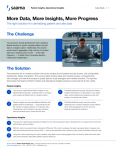Survey: research industry keen on DCT benefits, slow to adopt

According to a recent survey by software provider Climedo Health, companies that have made the jump to decentralized clinical trials (DCTs) have reaped a number of benefits. At the same time, those not yet using DCTs are experiencing barriers, including a lack of experience and insufficient staff.
Outsourcing-Pharma recently connected with Veronika Schweighart, chief operating officer and co-founder of Climedo, about the decentralized trials survey, including key takeaways and what the responses might indicate about the future of the industry.
OSP: Could you please share some of the reasons Climedo decided to undertake this survey?
VS: DCTs have become a major trend in the light of COVID-19, as they allow for trials – or a large part of them – to be conducted remotely. We knew that everyone was talking about them, but not how many organizations were actually using them and how they were benefiting from them. We had a feeling that Europe was a little slower to adopt them overall, as there is less coverage of them here compared to North America.
OSP: What do you think are some of the key takeaways from the survey?
VS: First, DCTs seem to offer clear benefits for those who use them, especially in terms of time savings, data quality, and cost savings. But companies also mentioned site and patient recruitment as well as retention, which, as we know, are always a major challenge in traditional trials and often the reasons why trials fail. Our respondents were able to quantify their savings or improvements too, e.g. an average of 30% cost savings, 39% time savings, and data quality which had improved by 41%.
Second, those companies still working with traditional clinical trials (TCTs) said they were struggling with high costs (58%) and time constraints (42%). Ironically, these are exactly the kind of issues that DCTs can alleviate. Lack of personnel was also mentioned by 49%, and since DCTs allow for the automation and acceleration of many processes, they can really help to take the burden off personnel. Companies not using DCTs seem to be very aware of the benefits of DCTs, citing cost savings, better patient and site recruitment, and savings as potential advantages.
Finally, companies working with DCTs believe that we need “more openness towards digital technologies” to foster the adoption of DCTs. Clearly, DCTs cannot be conducted with traditional data capture methods, such as paper or Excel sheets, and respondents claimed to already be using tools such as ePRO/eCOA, mobile apps, and telemedicine in their trials.
In the open comment section, they also mentioned a “drug to patient courier”, “web applications” and “eConsent” as tools. It seems that this first step into digital technologies represents a barrier for non-DCT companies – “lack of a provider or tool” was cited by 19%.
OSP: Were there any surprises?
VS: One thing that surprised us was that, despite the benefits mentioned across all organizations, 64% were still not sure whether they would be using them in the next three years, and 10% said they would not be adopting them. We expected companies to be more open towards DTCs, especially as the pandemic is not going away anytime soon and over 80% of non-DCT users rated the relevance of DCTs at 3 or higher on a scale of 1 to 5. Perhaps organizations are just missing one last little push to make the switch, which can be solved by working with an experienced provider, for example.
OSP: You mention in the announcement that adoption is still lagging. Do you think you could please share your perspective on what some of the obstacles to adoption might be for the respondents?
VS: Among those respondents not using DCTs, the top five factors holding them back were “lack of staff” (29%), “regulatory issues” (19%), “lack of provider or tool” (19%), the fact that their “trials cannot be conducted virtually” (19%) and “budget constraints” (15%). As a solution for “lack of staff”, one way could be to outsource DCTs or at least part of them.
Another argument could be that perhaps DCTs require more staff at the beginning for the implementation, but that they really pay off in the long-term, as they help to standardize and automate many manual processes, which removes the burden for personnel. Regulatory issues, the lack of a tool, and trials that cannot be conducted virtually could all be solved by talking to experts in the field, or industry peers in the same situation. For “budget constraints”, there will certainly be an initial investment as is always the case when implementing digital solutions, but the survey shows that DCTs result in valuable savings for companies.
OSP: Do you anticipate results might be different if the same survey were to be administered a year from now? Please share your thoughts.
VS: We would certainly hope that more companies will be using DCTs by this time next year since the benefits speak for themselves and even companies without DCT experience are very much aware of them. Currently, just 33% of our respondents have adopted DCTs, but 26% of those not using them plan to do so in the coming three years, which is encouraging.
We believe that viewing DCTs as a gradual process can be helpful, i.e. decentralizing certain parts of a trial step by step and not trying to take everything virtual at once. We also hope that companies will be reaching out to providers of digital solutions more to get started, and that “lack of a tool or provider” becomes less of an obstacle as a result.
OSP: Anything else to add?
VS: While it’s difficult to make geographical distinctions since the majority of our respondents were from Europe, we did notice some variations across different industries. Among all survey respondents, 27% were from medtech, 27% from pharma, and 17% were CROs. It would appear that pharmaceutical companies and CROs are more experienced with DCTs: They represented 33% and 36% of the companies with DCT experience, respectively. Medical device manufacturers, on the other hand, made up just 8% of this group. Among the companies with no DCT experience, 38% were from medtech, 24% were from the pharma sector, and just 6% were CROs.



















